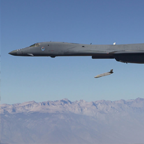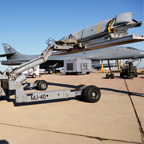
LRASM Prototype Is Three-For-Three On Successful Flight Tests
Latest launch evaluated low-altitude performance and obstacle avoidance as part of the joint program’s accelerated development effort

Initiated in 2009 in collaboration with the U.S. Navy and U.S. Air Force, DARPA’s Long Range Anti-Ship Missile (LRASM) program has been investing in advanced technologies to provide a leap ahead in U.S. surface warfare capability. The LRASM program aims to reduce dependence on intelligence, surveillance and reconnaissance platforms, network links and GPS navigation in electronic warfare environments while providing innovative terminal survivability approaches and precision lethality in the

face of advanced countermeasures. After LRASM prototypes completed two successful flight tests in 2013, LRASM transitioned from a DARPA technology demonstration program to a formal U.S. Navy program of record in February 2014, with fielding set for 2018.
On February 4, the Navy, Air Force and DARPA completed another successful flight test, marking a significant step in maturing key technologies for the future operational weapon system. The joint-service team, known as the LRASM Deployment Office (LDO), conducted the test to evaluate LRASM’s low-altitude performance and obstacle avoidance as part of the program’s accelerated development effort.
“We are very pleased with how LRASM performed today and we are looking forward to continuing integration efforts on the Air Force B-1, followed by our Navy F/A-18, over the next few years,” said Capt. Jaime Engdahl, the LDO’s Navy program manager. “We have a clear mission, to deliver game-changing capability to our warfighters in theater as quickly as possible.”
During the flight from the Sea Test Range in Point Mugu, California, a B-1B bomber released the LRASM prototype, which navigated a series of pre-planned waypoints to verify aerodynamic performance. In the final portion of the flight, the missile detected, tracked and avoided an object that was deliberately placed in the flight pattern to demonstrate LRASM’s obstacle-avoidance algorithms.
LRASM reflects initiatives from the Defense Department (DoD)’s Better Buying Power 3.0, which encourages rapid prototyping and other forms of innovative acquisition to keep a technological edge and achieve greater efficiency and productivity in defense spending.
“We’ve shown that by taking advantage of the Defense Department’s evolving acquisition policy, it is possible to significantly accelerate the fielding of a high-payoff technical system for the warfighter,” said Artie Mabbett, LDO director.
The LDO is developing LRASM as an air-launched offensive anti-surface warfare weapon to counter the growing maritime threats in anti-access/area denial (A2/AD) environments. Once operational, LRASM would play a significant role in ensuring military access to operate in open ocean/blue waters and the littorals due to its enhanced ability to discriminate and conduct tactical engagements from extended ranges.
